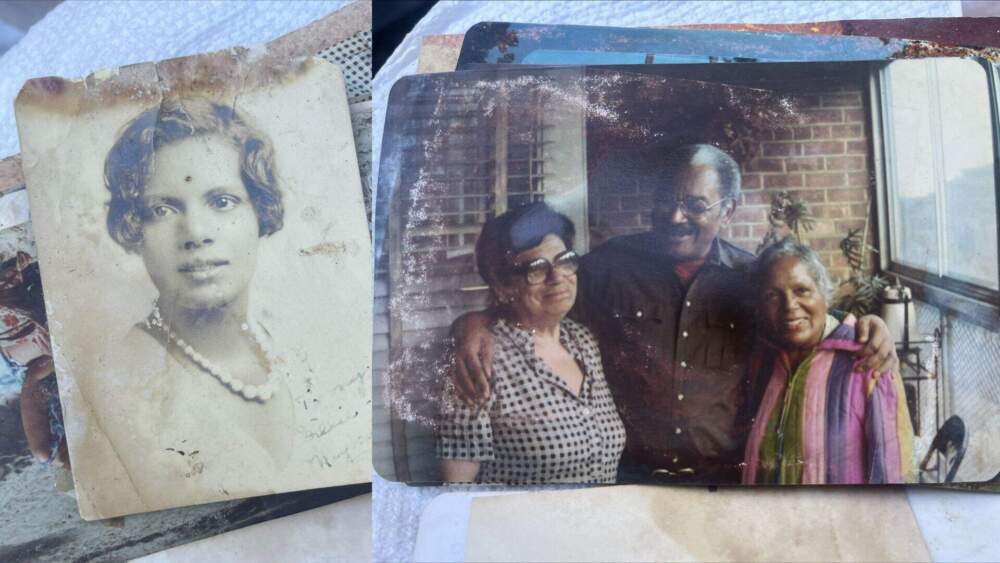A 1960 painting by Norman Lewis is up for sale, months after it was saved from a condemned Cape Cod house. Bidding for the colorful, abstract piece, which was painted on the interior façade of a chimney, starts at $40,000.
Christine Berlane is an arts specialist at Eldred’s, the auction house that currently houses the painting. She was heavily involved with saving the piece from the home of Marguerite and Hampton Gill, a couple from Harlem who spent summer at their house in South Dennis.
When the couple passed away, their house in South Dennis was inherited by relatives who lived out of state. Over the years, the home fell into disrepair which was hastened after a tree damaged the roof during a storm.
Berlane was contacted in the fall of 2024 by the relatives with hopes that she could help them save the piece by Norman Lewis. “It’s a lost painting,” says Berlane. “Nobody knows about it in the arts world.”
At the time, Berlane only had 25 days to figure out how to save the painting before the house was demolished. She contacted Ruberti Construction to come up with a way to preserve the chimney as the house was demolished. Old acquaintance and stone mason Conrad Languth inspected the chimney and told her that the piece could be saved.
In October 2024, the piece was saved and transported to Eldred’s in Dennis.
Norman Lewis and the Gills
Born in Harlem at the beginning of the twentieth century, Norman Lewis was a Black artist known for his emotive, abstract style. He is the only Black member of the first generation of the Abstract Expressionist movement that emerged after World War II.
After his death in 1979, Lewis fell into relative obscurity. But revived interest in Lewis skyrocketed in 2015 when the first comprehensive retrospective of his work was presented at the Pennsylvania Academy of the Fine Arts.
What struck Berlane, when she first saw the piece in the Gill’s home, was how similar it was to other paintings done by Lewis. “Even though it was abstract, to me it seemed very figural,” she says. “ It was pretty iconic of his really celebrated works of processions.”
The piece is unique because it was painted directly on a chimney, a rather untraditional medium for Lewis. “Many of his works were on canvas,” Berlane points out. “He did some works on paper, some prints. I haven’t found any other sort of work that he painted on an object.” If the piece were on canvas, it’s estimated that it would be valued anywhere from $1 million to $1.5 million.
From the Gills’ documents and additional research by Berlane, it was determined that Lewis was friends with the Gills and painted the piece during a visit to their home. While it is known that Lewis visited Massachusetts, it was not common knowledge that he specifically visited the Cape. The story of the Gills, the owners of the house, was another mystery.

“ The Gills’ belongings were strewn about the demolition site,” says Berlane. “ I was fascinated that a Black couple was in Dennis, Massachusetts during that time. They were both highly educated, they traveled a lot but there is virtually no information anywhere to be found on the Gills.”
Berlane collected some of those belongings from the construction site that included old photos, passport applications and even receipts for semesters at college.
Marguerite and Hampton Gill spent most of their time at their brownstone in Harlem and they owned properties in the Hamptons and South Dennis. “The Harlem Renaissance and then the fall of Harlem at that time, they lived through that all,” Berlane says.
According to family friend Elizabeth Wilkerson, Marguerite Gill, who had a heavy New York accent, was a lover of the arts and was also friends with legendary artist Romare Bearden. Marguerite donated two other works by Lewis to the Studio Museum in Harlem.
“This tells a story of Cape Cod.”
For Berlane, saving the Norman Lewis painting opened up many questions about Lewis, the Gills and the community of South Dennis. Did Lewis visit Cape Cod more than once? What influenced the Gills, a couple from Harlem, to buy a home in South Dennis? Was there a Black community in Dennis that convinced them to purchase property there?
“ I think that there’s a lot of knowledge about the African American population in [places like] Martha’s Vineyard,” Berlane says. “But there’s less information available about Dennis.”
When contacted, the Dennis Historical Society didn’t have much on any notable Black people in Dennis who would have lived there at the same time as the Gills. They did share the name of renowned Black architect, Henry Clifford Boles, who lived in Dennis around the same time period as the Gills. When the society shared what they believe to be his address, it was noted that it was only a five minute drive from the Gills’ property.
Given that the Gills were used to living in a predominantly Black, cultured area and that it was the mid-twentieth century, it seems that there is a possibility that there was a Black enclave of some sort in Dennis. Black people were known to buy in areas where they felt safe, namely places that boasted a sizable Black population.
If there was an existing Black community in Dennis, it would be a reason for the Gills to purchase property locally instead of other areas that were well known for their Black populations, like Hyannis, Mashpee and Oak Bluffs.
“ I would like [this history] to be explored a little bit more and to be more public knowledge,” says Berlane. “For the Gills, I just want them to be recognized and known more for who they were.”
The process has been about much more than saving a painting for Berlane.
“People disappear, but lives don’t. They existed. And that’s what I want to bring out. Their lives were important. And consequential.”









